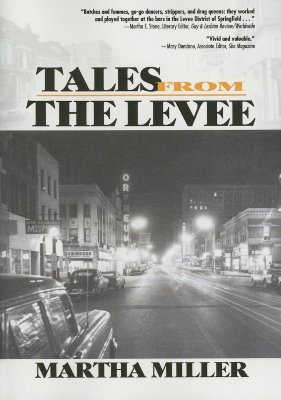- Welcome to FictionDB, Guest
- | My Account
- | Help

Tales from the Levee — Martha Miller
When the Orpheum Theater in Springfield, Illinois, was demolished in 1965, it marked the end of one era and the beginning of another. On the street where it stood, lesbians and gays found a haven in a strong, caring community, built from the need to separate from a society unwilling to accept them. Tales from the Levee tells these peoples' stories, spanning the years 1965 through 1976, when the Fifth Street Levee emerged as a thriving Midwestern center for the lesbian and gay culture of that time. It's all here: entertaining and outrageous real stories of love, lust, bigotry, and death.
Tales from the Levee centers on Casey, a masculine, part Apache lesbian born and raised in a small Midwestern town. Always knowing inside herself that she was not like others she knew, she escapes, moves to Springfield, Illinois -- to the center of town, where she discovers an area known as the Levee. The street, infamously sprinkled with several gay bars, a massage parlor, a hamburger stand, and apartments, becomes her new home. There she befriends and lives and loves with lesbians, drag queens, prostitutes, and gays also seeking a place they too can call home.
The book recounts the stories about the now-legendary characters that live there. Stories like:
the tale of the Cajun dancer, and the firestorm she caused
how Casey discovered the Levee
the Halloween party that ended in murder
how Little Red and Queenie finally broke up
Ella's funeral
how Tinkerbelle got her black eye
Babe's "specialty" at the massage parlor
and many more stories from the Levee!
Smoothly written with a constant eye on entertaining the reader, Tales from the Levee tells these stories and many more that are sad, funny, and at times disturbing.
An excerpt:
Casey's paternal family was West Texan Apache. Her father was killed in an oilrig accident when she was four. And her Irish mother returned to the small Southern Illinois town of her birth to raise her plump, dark-featured daughter among a large family of transparent-skinned redheads. Casey's earliest memories were of feeling different -- not belonging. She remembered her aunts and uncles as detached and uncaring. They seemed to hold something against her from the start. When her cousins teased her, for being fat or for being different, she was hurt and stunned.
One Sunday after mass her cousin Gerald called her a "half-breed." He'd heard the word on the Roy Rogers show. Then he threw a rock at her. She sat under a shade tree in the churchyard stoically. Her pink dotted Swiss dress was dirty and her black patent leather buckle shoes pinched her toes. She didn't fit in her family and didn't fit in her clothes. When her mother came to comfort her, Casey said as much, and then burst into tears.
The fair-skinned woman knelt and pulled the child to her. Casey could smell sweet lavender sachet on her mother's breast. She snuggled into it.
"Honey, this is just one small place in a great big world," her mother stroked her hair. "This is just one dull family in a world full of all kinds of people."
"I'm not like them," Casey sobbed.
"Being like other people is nothing. It's not even interesting. The only thing it is, is safe." Her mother told her. "Gerald and the rest are mean and rude. Who would want to be like them?"
Tales from the Levee takes a place and time of historical reality and through velvet storytelling makes it almost mythical, all while showing that people can thrive no matter what the challenges, as long as they belong to a community that cares.



